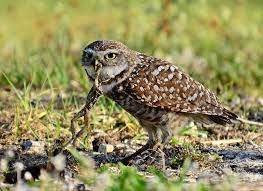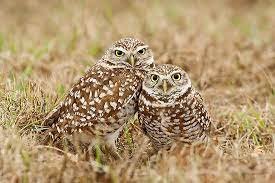Grasslands and deserts in North America, Florida, Mexico, the Caribbean, and South America are home to the burrowing owl, a species found nowhere else on Earth. These birds, as their common name suggests, lay their eggs in burrows dug underground, usually in sites formerly occupied by other species.

Insects and tiny mammals, such as beetles, grasshoppers, mice, and voles, make up the bulk of a burrowing owl’s diet. They spend a lot of time foraging, and as opportunistic eaters, they’ll go after anything that’s small enough to attack without getting hurt.
Bats, bunnies, snakes, and even birds as large as ducks have all fallen prey to these peculiar little owls. Like other types of owls, these birds are little but mighty in the hunt.
Physical Description

There is very little physical difference between male and female owls. The only distinguishing features between them are that girls tend to be heavier and males have longer linear dimensions, despite their similarity in overall size and skin tone. Since they spend so much time underground, females tend to appear more vibrant than males. The following are the most prominent distinguishing features of the burrowing owl:
Size (Length): The length of a fully grown burrowing owl ranges from 7.5 to 10 inches, and its wingspan can be anywhere from 21 to 24 inches. They’re about the size of an American Robin, give or take.
Height: These owls can range in weight from 4.5 to 9 ounces.
Feather/Coat and Tail: They have brown feathers on the head and back with white dots all throughout. The chest and belly are white, yet depending on the subspecies, they may have brown spots or barring.
Head: Similar to other owls, their heads are characterized by a spherical, flattened facial disc.
Eyes: Dark yellow eyes with well-defined brow ridges.

Ears: Located in the same space as the eyes but without tufts.
Legs: Their legs are longer and grayer than the legs of any other owl species.
Bill/Beak: The bill or beak of this bird is a sandy to golden tint.
Lifespan: Burrowing owls have a lifespan of nine years in the wild and ten with proper care as pets (in captivity).
Distribution
This owl species is found all across the New World, from Southeastern Canada and the western United States down to Florida, as well as in Central America, some islands in the Caribbean, and the middle and southern regions of South America.
Habitat

Burrowing Owls prefer to make their homes in gradually sloping, treeless, open regions. Grasslands, deserts, and steppes all include owls, as do golf courses, pastures, agricultural fields, airport medians, road embankments, cemeteries, and urban vacant lots. Commonly found in areas with lots of prairie dogs, ground squirrels, and tortoises, which all dig burrows. While owls in the breeding season tend to stick close to their designated nesting burrow, owls in the winter may wander around and may choose to roost in clumps of vegetation rather than in their burrows.
Also, know Do owls eat chickens?
What do burrowing owls eat?

Burrowing owls feed on insects and small animals like lizards, birds, and mammals. The bulk of the diet is composed of vertebrates, although the majority of food items are invertebrates, mainly insects. Grasshoppers, crickets, moths, beetles, mice, voles, and shrews are popular prey for burrowing owls. Bats, ground squirrels, small weasels, young rabbits, songbirds, waterbirds, baby ducks, and even juvenile burrowing owls are all fair game for these predators. It’s generally accepted that females are better at catching insects during the day, while males are better at catching vertebrates at night.
What is burrowing owls’ favorite food?
Beetles, various insects, mice, birds, and lizards are some of a burrowing owl’s preferred eats. On the plus side, their nutrition is fairly diversified. Burrowing owls are regarded as opportunistic eaters because they are known to consume a wide variety of different animals.

More specific types of invertebrates, like beetles, scorpions, grasshoppers, termites, dragonflies, and moths, make up the bulk of these owls’ diets. The majority of their daily biomass intake, however, comes from vertebrates. Other birds, bats, voles, ground squirrels, rabbits, snakes, lizards, frogs, and turtles are all fair game for burrowing owls, among many other animals.
How often do burrowing owls eat?
The burrowing owl is an opportunistic feeder, meaning it hunts and eats whenever it can. The owls hunt at all hours of the day and night, but they are most active at dawn and twilight.
Where do owls that dig burrows get their sustenance?
Burrowing owls employ two distinct hunting techniques, depending on the time of day and the type of prey being pursued. Most owls are active during the day when they can hunt insects from a perch or by strolling along the ground. The best times to hunt vertebrates are just before dawn and just after sunset when the animals are most active.
The burrowing owl uses its keen talons to catch prey, which it then carries in its beak back to its underground home.
When do burrowing owls eat during the day?

Crepuscular hunters, like burrowing owls, are most active in the early morning and late afternoon. There are other times of day when owls are also foraging and busy. They tend to be sporadic in their activity throughout the day.
Nesting
Nesting owls frequently select places with a large concentration of nearby burrows, which may provide additional refuge for young owlets. Loose soil, some height above the surrounding area to prevent flooding, and adjacent lookouts like dirt mounds, plants, fence posts, or road signs are all desirable features. Prairie dogs, ground squirrels, badgers, marmots, skunks, armadillos, kangaroo rats, and tortoises all make use of tunnels made by other animals. By using their beaks to dig and their feet to kick back earth, both partner pairs work to expand and maintain the burrow. In the west, owls rarely dig their own burrows, but in Florida and the Caribbean, they do so almost exclusively. Burrows are used constantly by owls that do not migrate.





